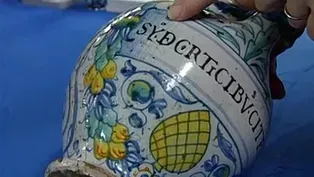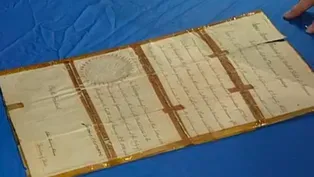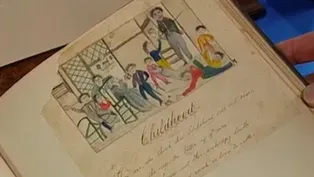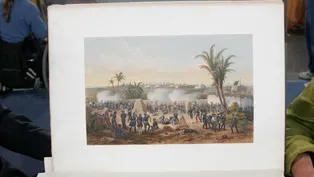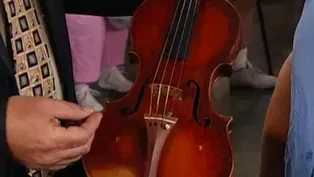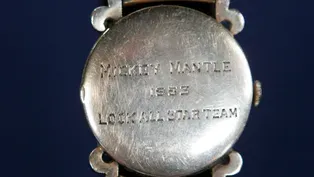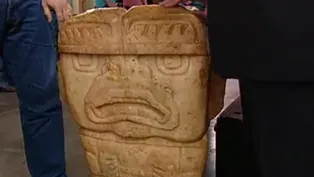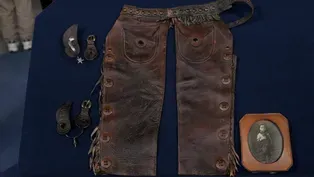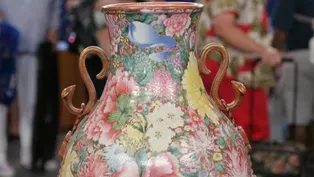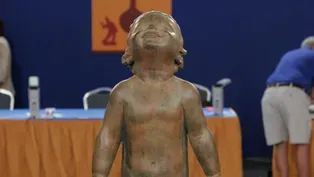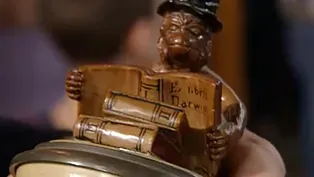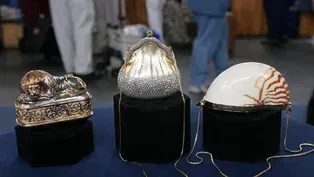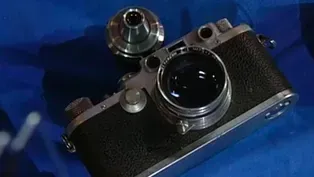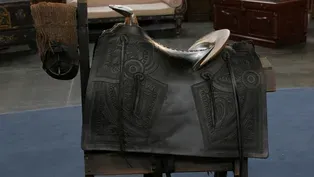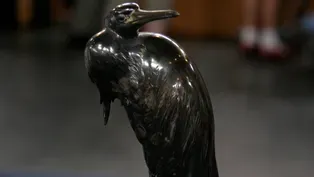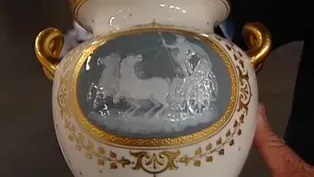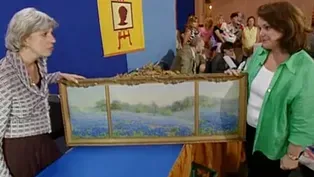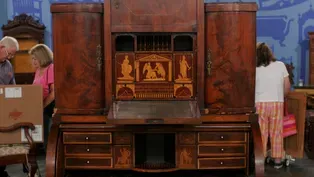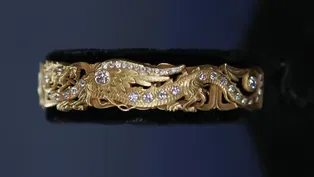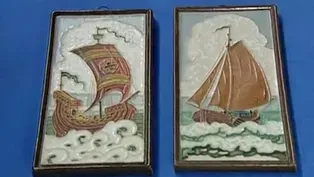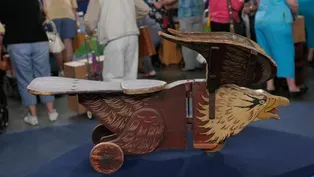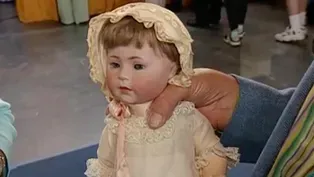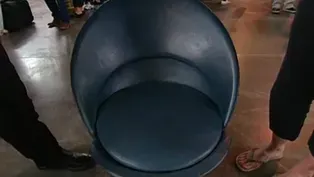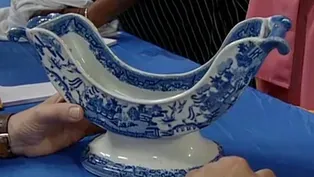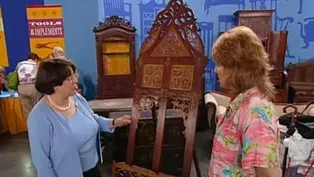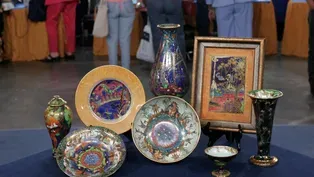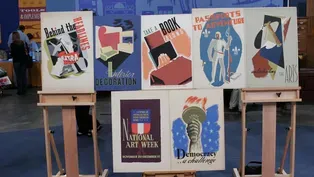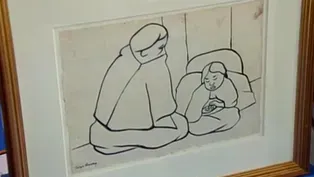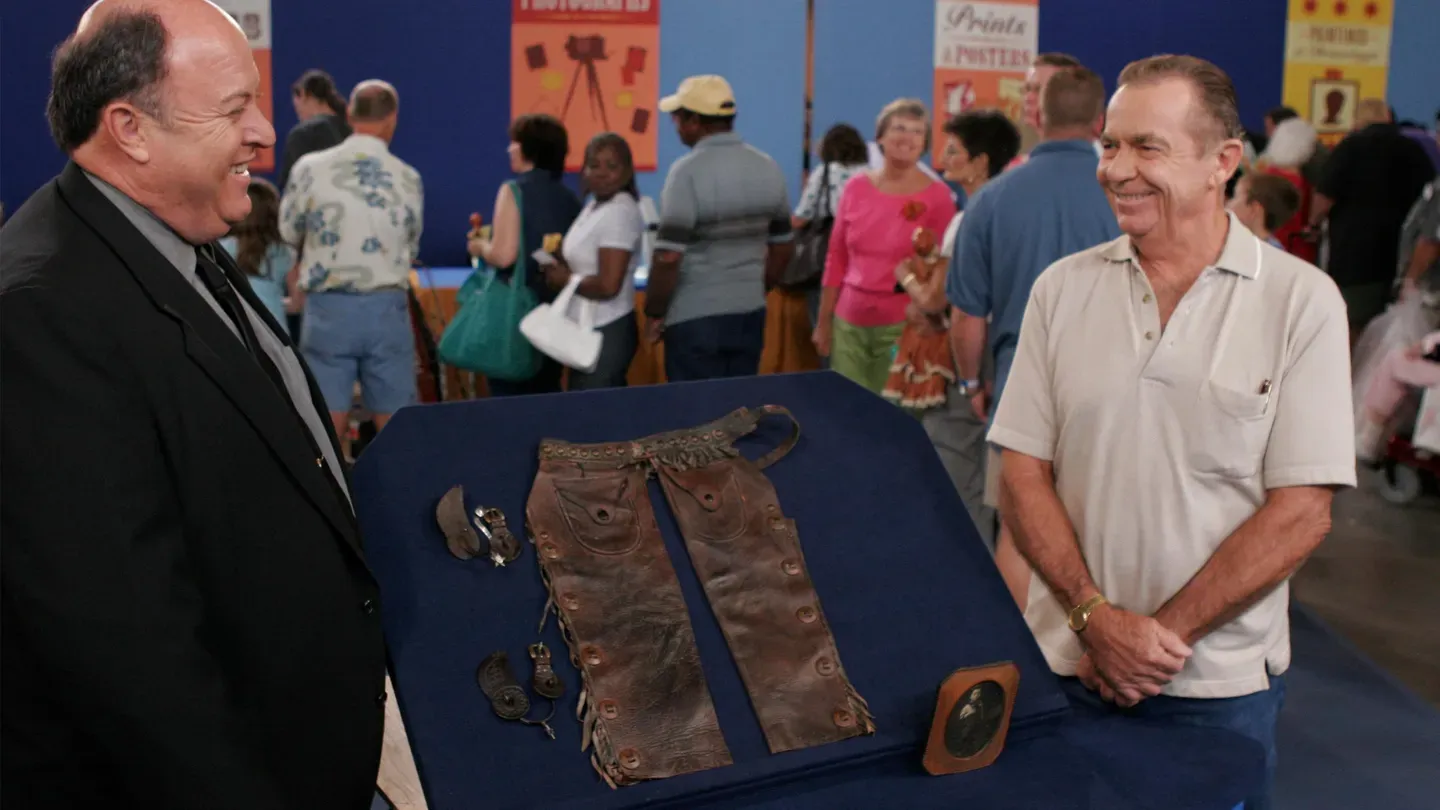

Vintage Houston
Season 23 Episode 19 | 52m 32sVideo has Closed Captions
Everything is bigger in Texas—including the updated values of treasures from 2005.
Everything is bigger in Texas—including updated values of treasures from 2005 such as a 1953 Mickey Mantle All Star watch, an 1840 Texas Artillery short sword, and an Edith Parsons "Turtle Baby" fountain. Find out more in Vintage Houston 2019!
Problems with Closed Captions? Closed Captioning Feedback
Problems with Closed Captions? Closed Captioning Feedback
Funding for ANTIQUES ROADSHOW is provided by Ancestry and American Cruise Lines. Additional funding is provided by public television viewers.

Vintage Houston
Season 23 Episode 19 | 52m 32sVideo has Closed Captions
Everything is bigger in Texas—including updated values of treasures from 2005 such as a 1953 Mickey Mantle All Star watch, an 1840 Texas Artillery short sword, and an Edith Parsons "Turtle Baby" fountain. Find out more in Vintage Houston 2019!
Problems with Closed Captions? Closed Captioning Feedback
How to Watch Antiques Roadshow
Antiques Roadshow is available to stream on pbs.org and the free PBS App, available on iPhone, Apple TV, Android TV, Android smartphones, Amazon Fire TV, Amazon Fire Tablet, Roku, Samsung Smart TV, and Vizio.
Buy Now

ANTIQUES ROADSHOW 2025 Tour!
Enter now for a chance to win free tickets to ANTIQUES ROADSHOW's 2025 Tour! Plus, see which cities we're headed to!Providing Support for PBS.org
Learn Moreabout PBS online sponsorshipHe would sometimes sign your name on the side of the piece, and then he wouldn't let you have it.
Oh, my goodness... Oh, my goodness.
I am thrilled to death.
You're kidding.
APPRAISER: No, not at all.
I knew I loved her.
(laughing) ♪ ♪ MARK WALBERG: In 2005, "Antiques Roadshow" took a trip to the biggest city in Texas, Houston.
14 years later, we're taking another look at these treasures and discovering if the values have increased, decreased, or stayed the same.
Think you know what the updated values could be?
Test your knowledge in this fresh look at Vintage Houston.
MAN: Brought a spur and chaps and a picture of my uncle.
He was born in 1910.
About three years old, it looks like, when he was wearing these.
About all I can see on the spurs is the silver centavos, and I believe the rowels are coin-- cut-out coin.
APPRAISER: This is the rowel.
And his name is Jack Burke, which is in-laid in silver across there.
Yes, sir.
Where do you reckon those spurs came from?
Mexico, I think, because of the "centavos."
He's not wearing the chaps in the photograph.
Right.
I wish he was, but he's not.
These are shotgun chaps, they're called.
And they're real typical of the trail drive era.
Then the styles changed to those big batwing chaps that you probably grew up with and that I had seen.
Right.
But these narrow shotgun style's a real old style.
I've never seen a pair this small.
I think they were made for him.
They're too unusual.
So they kind of had him dressed like an old-style cowboy.
(laughing) Now the spurs.
They're not from Mexico.
The fact that they have Mexican coins on the buttons... Uh-huh.
The way the engraving is, with his name on the side, the five-pointed-star rowel, it's all the hallmarks of an Italian spur maker in Victoria, Texas, named Joe Bianchi.
He made spurs for everybody who was anybody and everybody who was nobody in south Texas.
And he made them for cowboys, ranchers, some of the biggest ranchers you've ever heard of in Texas.
Your uncle is wearing the spurs in that photograph, which is a neat documentation of them in use.
They're the smallest Bianchi spurs I have ever seen.
The chaps, if they were marked, would be worth more.
But as it is, they're probably worth $1,200 to $1,500, which is pretty good for little kids' clothes.
Uh-huh.
The spurs are easily worth the same.
So we're talking $2,400, $3,000.
It's great stuff, and child's gear is particularly desirable right now.
WOMAN: This bracelet was given to me on my birthday, passed down to me from my mother, and it came from her aunt, and it was passed to her from her mother.
APPRAISER: Okay, and do we know what country they came from?
My great-grandparents were from Germany.
It's actually an American piece.
It's by a company called Rikers, they're based in Newark, New Jersey.
You can actually see it on the clasp.
There is a "14K," which is the American gold mark.
And underneath, there is a mark for Rikers, which is a sword with an "R" above it.
Yes.
And this was done in about 1900s.
The piece is in the Art Nouveau style.
It shows a dragon set with old-mine diamonds.
It's all done in 14-karat yellow gold.
Did you have any idea as to a value on the piece?
Has anyone ever told you anything about it?
No, I took it to have it just evaluated because we weren't sure, and someone did tell me that they were old diamonds.
But they weren't willing to give me an appraisal.
The conservative price on this, that the piece would probably fetch, is around $8,000 to $10,000.
(laughing): Wow!
Did you like that?
It's an incredible piece.
I mean, it really is.
It's absolutely superb.
That's awesome!
WOMAN: I brought in this, what we believe is a Texas sword.
It was given to my husband's father back in the mid-'50s by a man who said that he found it when he was working on the construction of the San Jacinto monument back in the mid-'30s, where the Battle of San Jacinto was fought back in the early 1800s.
Right.
It is a Texas artillery sword.
At the top of the sword, we have the famous lone star from the State of Texas.
This sword was actually manufactured in Cabotville, Massachusetts.
I'll be darned.
It was made by the Ames Manufacturing Company, the most famous sword maker of the day.
They made them under contract for the State of Texas.
They have that fierce look, the Roman gladiator sword.
It's patterned after the model 1832 short artillery sword.
It would have been made prior to the Mexican War.
This pattern they actually made up until 1861.
There is a version that has an eagle.
Yes.
Up on the top of the pommel.
We've seen that.
That's the standard U.S. sword.
They made several thousands.
Okay.
The one with the star, since it is a state contract rather than a government contract, they only made 40 of these.
The handle is actually made of cast brass, and the sword, being iron, they run the blade through the handle, and they peen the blade and the handle together to keep it from coming out.
We do have a couple of condition problems, which will hold the sword back.
Originally, it would have had a leather and brass scabbard that sheathed the sword when it wasn't in use.
Right.
That's missing.
Also, the blade has been re-sharpened several times.
It originally would have been just a little bit wider.
And at one time, it would have had the date of manufacture at the base of the blade.
It also would have had the Ames Manufacturing mark.
So those will hold it back from bringing top dollar.
Right.
When I referred to some colleagues, they thought that the sword would bring about $2,000.
My opinion was, it's a wonderful piece.
We know the battle history.
It's a rare piece, compared to the regular quantities that they issued.
I think that it would bring closer to $3,000.
So that just lets you know that it's all in the eye of the beholder.
Terrific-- thank you.
It's a German stein.
Okay.
It's probably from the early part of the 20th century.
It's basically a spoof on Darwin.
Oh.
You have this monkey up here on top reading Darwin's book.
Okay.
And then over here, it actually says on the outside, "Ex libris Darwin."
And then you have all these monkeys cavorting on the bottom.
Cheese cradles are pretty much unique to British pottery.
This one was made in the early years of Queen Victoria's reign, I would say around 1840, 1850.
We see very few of them.
This is the first one, actually, that any one of my colleagues or I have seen on "Antiques Roadshow."
These are Delft tiles, as you know, made in the city of Delft in Holland.
They're made by the oldest surviving pottery from Delft called De Porceleyne Fles, and these are very Arts and Crafts movement in their style, in their decoration.
MAN: Well, this piece belonged to my parents.
They had it out at their pool, and from what I understand, it came from Mexico in the '50s.
We paid about $500 in about 1962.
Now, I know that you had this thing tested, and they found no evidence of modern tool marks.
Yeah, correct.
Now, the problem is that you needed to have the thing evaluated from a stylistic standpoint, and stylistically, this is not even close to what Olmec should be.
I see.
Olmec has great balance.
It's tight, it's elegant, and this piece is not that.
Now, that's the bad news.
The good news is that even on the decorative market-- not the fine art market, but on the decorative market-- this piece is still worth $1,500 to $2,500.
Now, the bad news is, had it been real, a major Olmec piece like this would have been well into six figures.
(inhales): Wow.
Now, didn't I make your day?
Yeah, you made my day.
(laughing) It's at least from the, before the 1840s.
Okay.
It was in the Samuel Morse family, and...
The inventor of the telegraph.
The inventor of the telegraph.
Famous, famous guy.
Yes-- his daughter married a landowner in Puerto Rico, and I believe her husband, Mr. Lynn, bought this desk for her in England and had it shipped to the island.
I see.
And because they lived kind of out in the wild, they didn't have a way to protect their things, so this desk has lots of secret compartments.
Okay.
I don't even know if I've seen them all, for them to hide their money and their papers, because there were thieves in the island.
Okay.
And you've inherited this?
My mother bought this in the '70s in California.
Okay, okay.
And it had a letter in it that was written in 1935 by one of the descendants of the Morse family.
Well, it's one of the most fascinating pieces I've ever seen, I have to tell you.
Really?
And the more you look at it, the more treasures you find.
Look at that.
Isn't that great?
Yeah, yeah.
And this was maybe on a plantation?
Yes.
Because you open up some of these doors, and you have notations about bills, what they kept in here-- folios and records and journals on the farm, on the plantation.
Oh, right?
Then you have these figured panels in this very Neoclassical style, with this satinwood inlay with these figures.
And the overall form with the cylinder front, and it has these spade feet on the bottom, which are perfectly formed, all of that points towards the Baltic states, Northern Europe, around 1820.
Look at this figure.
She is holding a staff, and that's Athena, the goddess of wisdom.
The goddess of wisdom.
Exactly, with the owl here.
Okay.
And on the left side, this is Hera, who is the goddess of marriage.
And this is a little temple here.
This is a brickwork wall, which goes with the whole architectural idea.
And you push this with your finger here, and then now, if you go underneath here, this pops and comes out.
Okay.
And what we have here is a spring lock.
Okay.
So I push my finger through here and it pops through.
Okay.
And in the back is an iron spring.
Uh-huh.
So it's all spring-loaded.
And then if we push this panel in here, this comes out.
Oh!
And here's another...
I have never seen this.
Here's another drawer.
Oh, wow!
You didn't know that was there?
No.
Now, I checked in there earlier.
Unfortunately, there's no gold in there.
Oh, okay.
But it's just incredible how many secret panels.
This upper section... Oh, no!
...to hold little receipts, comes out.
Okay, wow.
Look at that.
And back here, in fact, you pull this out, and... Oh, my goodness.
...hidden back here are little tiny secret drawers in the back.
Oh, no.
So...
I had a feeling we hadn't seen all the compartments.
This would have held probably a little porcelain figure, a piece of silver there.
And these are all drawers, with secret ones behind.
There must be...
Behind them, there's more?
There's more.
And look at this.
Oh, my goodness.
This pulls out.
Did you know that came out?
No.
This is where they really kept the treasure, back here.
Oh, no!
Look at that.
Oh, my God!
I mean... Oh, that's too much.
Well, I'll bet not many burglars found that one.
That's fantastic.
While the hardware is old, and it's perfectly for this piece, it's about the third set of hardware.
Oh, really?
You've taken good care of it, though.
I mean, these things are pretty minor, you know?
Oh, good.
Now, do you have any idea of the value on this?
No.
I know that my mother paid $750, and I've always thought, "Well, it's got to be worth more than that."
Well, because of the complexity of this and all the secret drawers, and all this wonderful inlay, if I were insuring this, I'd put the figure at about $20,000.
(laughing): Oh, my God.
Okay.
$20,000 I should insure it.
All right, I shall do that.
It's a beautiful piece.
Wow.
WOMAN: I had an aunt that collected the Overbeck, and then she decided that she wanted to commission the center guy there.
So she had it made up.
And that's how I got it.
We've got a newspaper article here that talks a little bit about Mr. Curry.
This was a piece that your aunt had the Overbeck sisters do specifically for her.
Right.
Who is Mr. Curry?
Well, he's a runaway slave.
Everybody knew Wade Curry.
As I understand it, he was the first slave to be buried from a white church.
It was a Quaker community, and, of course, the Quakers helped the Underground Railroad.
Right.
So... And Mr. Curry was one of the messengers with the Underground Railroad.
And he was a messenger, and everybody just loved him.
And so she decided that everybody needed to remember him.
Just a little history about the Overbecks.
They lived in Cambridge City, Indiana, and there were six sisters.
There are a couple of interesting styles.
Some of the sisters were very well trained, and pieces like this small vase with the houses were done by Elizabeth and Mary Francis.
Some of the other sisters did the little grotesque pieces, like Mr. Curry.
And they're called grotesque characters because generally, they're out of proportion, and sometimes the more grotesque they are, the more valuable they are.
We've got a praying mantis, we have a Southern belle, a colonial gentleman, and then we have this very interesting bowl with a flower frog that goes inside the bowl that sort of fall into the grotesque category.
And then we go back to the vase with the houses on it, which is a little bit finer, and probably a little bit earlier.
The praying mantis is really rather unusual.
I think he probably, even though he's very small, might be $400 to $500.
The Southern belle and the Southern gentleman, he has a little damage, but they're maybe in the $300 to $400 range each.
The bowl with the flower frog, which is quite unusual, I'd say combined value of those two pieces-- they do go together-- is probably $1,000 to $1,500.
Mr. Curry, who is one of the more unusual pieces because he is a commissioned piece, done from a living person-- I've only seen a couple like that ever-- I suspect he's worth close to $1,000 himself, maybe more in a good market.
Wow.
So that gets us down to the little guy with the houses.
This piece is probably worth somewhere in the neighborhood of $3,000 to $4,000, maybe a bit more on a good day.
Goodness.
If all these were sold at auction, they would bring roughly somewhere between $6,000 and $7,500.
That's a lot of money.
WOMAN: These are from my mother's collection.
She purchased them in Dallas at Neiman Marcus, from Stanley Marcus, in the '60s or the '70s.
So she carried them to balls, and they were quite unusual, and I think they're very beautiful.
These are Judith Leiber bags.
And Judith Leiber is a renowned purse company.
She came from Budapest after World War II and started her own handbag company in 1963.
She is coveted by celebrities, socialites, and these bags are in museums, like the Metropolitan Museum or the Smithsonian.
She always had a very great sense of humor.
It was either bejeweled gold bags or wonderful lions resting, or the fabulous seashell, which she also has in her book.
They are also sold today, but they've been selling in stores since 1963.
They now are known as collectibles.
They're extraordinary.
They're extravagant.
They're so different, a departure from any other evening bag made or known in America.
This one, from 1963, would now be worth about $600.
This one-- all these stones are hand-done.
Oh, wow.
She had craftsmen do everything very, very neatly.
And this would be worth between $600 and $700.
Now, this one, which is the shell bag, it's very well-documented, and people just love the shell bag.
I would say this, at auction, would be about $1,200.
Wow.
That's impressive.
That's great to hear, as my mother has a collection of about 20 Judith Leiber handbags, so that's very nice news.
(laughing): You're in business.
I realize that they are from the WPA period, the 1930s, here in America.
And they were part of a group of posters that became available to me through two elderly ladies who had taught at the Art Institute of Chicago.
They are, in fact, the work of the WPA, from Chicago.
And each one of the posters says, "The WPA Art Project," either Chicago or, in some case, it'll say Illinois.
Only two of these posters are signed.
And to be honest, the names that are on them are not particularly major names.
These are all from 1936 to 1941.
The WPA employed over 5,000 artists, and they produced thousands and thousands and thousands of posters.
It was the way for unemployed artists in America during the Depression to find some work.
It was a really, a great program that benefited America as a whole.
And a lot of the WPA posters concentrated around cultural events.
And that's largely what we have here.
We have National Art Week.
We have Understanding the Arts.
We have a poster that encourages people to read more.
Now, they're all silkscreens.
All of those posters were actually printed on board, and this is why very few of them have survived.
Silkscreen actually scratches very easily.
You can see a few scratches in this image, but not, not so bad.
You've kept these in really good condition.
And usually with WPA posters, the board will crack, or the images will get scratched, so very few of them have survived.
This poster dates from 1940.
This poster dates from 1941.
Now, the Library of Congress has the largest collection of WPA posters in America, with over 900 images.
But I have to tell you, in the ten years that I've been conducting poster auctions, I have never seen so many WPA posters at once.
Oh!
But I usually see one at a time.
If I'm lucky, in a great year, I'll see three at a time.
But here we're showing five of them.
You have another one here.
So a total of six.
Plus about three or four or five more that I don't have with me.
These posters have become so popular in America now, I would estimate, at auction, as a group, the six pieces that we have here at $10,000 to $15,000.
Oh, my!
A really extraordinary slice of graphic Americana.
Well, that is very exciting news.
What's so exciting about a painting like this in Houston is, you know, Holland has its tulips, and you have... Our bluebonnets.
You have your bluebonnets.
And they are extraordinarily popular, a woman artist.
I would be estimating it now at between $15,000 and $25,000.
That's great.
It is what is called a wet drug jar.
And the name that is here on the front is the name in Latin of the drug that would have been kept on the inside.
And as close as I can come, it's syrup of camphor.
The piece does have a date on it of 1584.
The Linhof, first of all, is really the kind of camera that a lot of the news reporters used during World War II and a little bit after the war.
And then they moved to the smaller 35-millimeter-format cameras with these Leicas.
As far as 35-millimeter camera goes, Leicas are the top of the line.
They're the best cameras, and as a result, their stock continues to rise today.
You've got here, really, like, the top end of the cameras that were made for their time.
I was helping some friends clear out their house for an estate sale, and no one else wanted it-- that's it.
So they gave it to you?
Mm-hmm.
You didn't have to pay anything for it?
Nothing.
It was designed by a designer named Verner Panton, one of the most important architects, designers of the 20th century working in Denmark.
He died just a few years ago, and this is one of his most iconic designs.
It's called the Cone Chair, because of its distinctive shape.
This model is a very early model, and it dates from the earliest production period, of about 1958.
It has the Plus Line label inside.
The early construction is also noted with a metallic interior, and it's wrapped in vinyl.
Now, the condition is not in great shape, so the value is not quite as high as if it was in perfect condition.
In this condition, because it's an early model, it would sell for about $800.
Wow.
Pretty good, for nothing.
Pretty good for free, right?
What you can tell me about George Ohr, the Mad Potter of Biloxi?
I know that he chopped his own wood, built his own kiln.
And I think he rode around town on a bicycle, just kind of listened to his own drummer.
He was a real hardcore Arts and Crafts potter from Biloxi, Mississippi.
And he had bulging muscles.
He dug his own clay from the Tchoutacabouffa River, and he'd be wheelbarrowing it through town.
He had arms like Popeye.
He was an artist, so he was a little wacky.
It's okay.
He was very attached to the pieces that he made.
He called them his mud babies.
Let's say you were to go there and watched him make a pot.
He would sometimes sign your name on the side of the piece and then he wouldn't let you have it.
So, consequently, most of what he made stayed within his possession.
In October of 1894, his pottery burned down, in the Great Biloxi Fire, and he lost everything he had.
And he was poor to begin with.
But he loved his pots so much that he went into the ashes and he salvaged boxes of his pots, and where he used to call them his mud babies... Mm-hmm.
After the fire, the ones he saved he called his burnt babies.
Okay.
And this is one of his burnt babies.
All right.
Okay, you can see on the surface this kind of gnarly texture.
Yes.
It's because it blistered the glazes.
So we know this pot dates to 1894 or earlier.
Also, this particular mark is one of his earlier marks.
Now, you bought this from... An online auction.
Online auction, okay, and you paid... $1,200.
$1,200 is about twice what it's worth.
This piece today is worth retail about $600.
Okay.
They used to be unsalable.
But his work has become so valuable over the years, that they've risen considerably.
This probably went from $100 to $600 in the last ten years.
The architect Frank Gehry is building a new George Ohr museum in Biloxi, Mississippi.
Mm-hmm, okay.
And people are already anticipating price rises for Ohr's work because of that museum, which is going to put George Ohr on a world stage.
While it's not worth what you paid for it, I think it's only a matter of time before we get there.
Okay, very good.
MAN: This eagle belonged to my mother when she was a little girl.
My mother's 89 years old.
She was born in 1916.
So we think that my grandmother bought this eagle for her about 1918 or 1919.
We were cleaning out my grandmother's closet after she died, and this was back in the back of the closet.
It hadn't been touched for years.
There's an emblem underneath telling where it was made.
So we do know it's a manufactured piece.
It was made by S.A. Smith in Vermont.
They were makers of a wonderful array of wooden riding toys.
I can remember the first one of these I saw was about 35, 40 years ago, when I first got in the business.
And we didn't know it was manufactured.
We thought it was a folk art piece.
And then we discovered that Smith had made them.
And they made a battleship.
They made cars.
And they all were made with this flat wood construction.
But we've always found that this is the most spectacular piece they made.
It was made right around 1895.
Wonderful piece of patriotic Americana, even down to the shield right here on the seat.
"America."
The child would sit here, of course, and this is how he would steer.
So it's a wonder any of them survive.
I've seen three or four over the years.
The last one of these I know of selling at auction sold about ten years ago for $2,500.
This could easily bring $3,000 to $4,000.
Oh, my goodness.
I am thrilled to death.
It's because it's in such great condition.
It's just a fabulous piece.
My mother is going to absolutely be thrilled.
WOMAN: This is a book about the war between the United States and Mexico.
I bought the book because I love history, and it has beautiful pictures in it.
I actually knew about the prints in the book, and I had bought two of these prints from a print shop in Dallas many years ago.
And then when I saw the book, then I thought, "Oh, good.
"Now I'll have 12 more prints, and I can make a nice wall hanging."
And then after I saw how exquisite the pictures were and the beautiful text, I simply couldn't butcher the book.
I've had it for at least 15 years.
I bought the book from an estate.
The dealer had a particular price on it, and he and I negotiated a price, and he was a very nice man.
He let me pay off in time.
And Christmas came one year, and my husband said, "You know, I don't have a present for you for Christmas."
And I said, "Oh, I know what you can do.
You can go pay off my debt."
The balance?
The balance.
That's how I got the book.
So you...
So you got debt-free for Christmas.
Absolutely, absolutely.
Can I ask how much you paid?
$4,000.
$4,000.
Well, the book, as you know, is entitled, "The War Between the United States and Mexico, Illustrated."
It's by George Wilkins Kendall, who was really the first great American wartime correspondent.
Oh.
He went to war alongside with the soldiers.
He was out there taking notes and corresponding back to his newspaper.
And it was very important to him that not only were the words accurate, but so, too, were the illustrations.
Mm-hmm.
And you were right, the illustrations in this book are magnificent.
Carl Nebel was the artist.
Right.
He also accompanied Kendall along on the journeys and the battles, and did his sketches on site.
They're lithographed plates.
The plates were lithographed in Paris.
And Paris had the greatest lithography in the world at the time.
They're hand-colored, and you can see, all these details are picked up with shines, and gum arabic was used to heighten some of the parts of the illustrations for drama.
This is my favorite picture of all.
Your favorite one.
Yes.
General Scott's entrance into Mexico.
The end of the war, basically.
And here's Scott coming in.
The plates were lithographed by the great lithographer Bayot.
Between the combination of the great artist, the great text that Kendall wrote, and just the beauty of the execution of the entire book, it is a magnificent creation.
Even here he says, Kendall, at the end of his preface, he says, "No country "can claim that its battles have been illustrated "in a richer, more faithful, or more costly style of lithography."
The market, since you bought this, has made some incredible jumps, especially when it comes to color-plate books, particularly with, with relationship to American history.
A copy of the book in roughly the same condition was sold at auction for $35,000.
Really!
Yes.
I am astonished.
Insurance would be $45,000 or $50,000.
You want to keep it in the way it is, as it's been kept, but it...
I must say, I'm reeling from this estimate.
Spectacular.
I am overwhelmed, thank you so much.
I'm astonished.
APPRAISER: It is Minton pâte-sur-pâte, which means paste on paste.
And this is a very expensive and very time-consuming process of building up layers of liquid slip to make these very intricate, detailed designs.
And they are on both sides of the vase.
This is a wonderful example, great quality, and a real treasure for you to have inherited.
On the inside, it's also, has this maker's stamp.
In several places it's stamped Oreste Candi, but the quality of the craftsmanship is not quite what you would typically expect from this maker.
It would be what we would consider a shop instrument.
APPRAISER: What's wonderful about it is, they've taken an easel, which is something that could be very plain, and they've just really embellished it to the nines.
It dates from the late 1800s, probably the 1870s, 1880s.
It's sort of-- it's a Victorian piece.
WOMAN: I brought you this doll that's been in my family for a long time.
It belonged to my grandmother-- my great-grandmother.
Mm-hmm.
And I always loved dolls.
She had a big collection in her house in New York City.
When she died, she left me this doll.
And it's been kicking around in my house for a long, long time.
Okay, it's a German doll.
It's what's been called a character doll.
It's not like a little dolly face.
It looks like a real child.
Now, this doll was produced in Germany by a company called Simon Halbig around 1910.
It has what they call an open/closed mouth, no teeth, composition body, original mohair wig, original clothes.
It's in lovely, lovely shape, very hard to find.
Probably value... Oh, on a real bad day, maybe $2,000.
On a real, real good day, probably $4,000.
WOMAN: My mother, when she was growing up, used to go to the Cleveland Museum.
And she loved "The Turtle Baby."
And when she married my father, they moved to Houston.
And she had pictures throughout the house of "The Turtle Baby" when I was growing up.
So my dad, on their 25th wedding anniversary, surprised us and said that we were going to New York for a visit.
So we flew to New York, and my dad handed an address to the taxicab driver.
So we drove, thinking we were going to the hotel, but in turn, we stopped at a gallery.
And there was "The Turtle Baby" draped.
They had an unveiling.
He said, "Happy 25th wedding anniversary, Mama."
And what was her reaction?
She almost fainted.
Your father actually contacted the dealer... Edith Parsons.
...to have it commissioned and have it cast?
Yes.
In 1959, it was?
I believe it was 1959.
Yeah?
And you have that correspondence, which I looked at.
And he paid $1,150 for it.
That's correct.
Plus $20 to ship it to Houston.
Edith Parsons was an American sculptor.
She was born in the 1870s.
She studied in New York at the Art Students League, and one of her teachers was Daniel Chester French, who is the famous sculptor of the Lincoln monument in Washington.
And she was one of a number of women artists at this time, in the teens and the '20s and '30s, who did outdoor sculpture.
There was a great big building boom.
A lot of people had country houses, and they wanted these outdoor sculptures.
And Parsons did this wonderful one called "The Turtle Baby."
She did one called "The Duck Baby."
She did one that was "Frog Baby."
"Frog Baby."
I've seen it.
And they're all very similar in conception.
You have this wonderful little girl...
Yes.
With this incredible sort of ecstatic expression... Glee.
Grabbing each of these turtles by one foot.
And then her glee is somehow also translated into the actual way her toes are raised here.
Toes.
And then you have the base is supported by turtles, and water spouts out.
Out, right.
So was it set up in your house, in your yard?
Outside, my mother and dad had an enclosed brick patio made with a fountain.
And then when they passed away, I took it.
And now you keep it indoors, yeah.
I've been keeping it indoors.
Yeah, yeah.
Because it has been outside.
It affects the value somewhat, but it's just a wonderful piece, it's one of the great examples of American 20th-century garden sculpture.
If we had this in our shop, we would charge between $35,000 and $40,000 for it.
You're kidding.
No, not at all.
I knew I loved her.
(both laughing) WOMAN: It belonged to my great-aunt.
She got it around 1915 to 1920, I believe.
And my great-grandfather, who was her father, paid $100 for it.
I just know that she was on the radio.
She said she broadcasted her music.
These instruments were popular for Hawaiian music.
In fact, this was made by the Weissenborn company in California, and Weissenborn was active from about 1920 into about 1937.
It was played with a slide.
Yes.
That's why it doesn't have raised frets.
It has these individual wood inlaid markers.
This is made out of flamy Hawaiian koa wood.
I think he was the tastiest, the cleanest of the makers of this type of guitar.
A lot of people were reproducing this sort of guitar in those days, but this guy made the most beautiful ones.
Oh.
And I think, also, they used the nicest wood selection, which even today is expensive to buy.
This is a grade four, which is the highest grade they made.
They made one, two, three, and four.
The one would have been very plain koa wood with none of these rope bindings.
And these are individual alternating wood pieces, dark and light.
And you'll see it goes all the way around the top, and also around the back, up the finger board, around the head, and that's what makes it grade four.
I imagine they went up in grade from maybe $25 to $40 to $75.
In this case, perhaps $100.
$100.
The Hawaiian craze was at its height in the mid-1920s.
Everybody is producing Hawaiian instruments.
Unfortunately, shortly after he made these...
I don't know if you've ever seen the metal resonator guitars.
I have.
Made by National and Dobro companies.
Okay.
Well, they really replaced these guitars.
So after a while, Weissenborn couldn't sell them.
At some point, it would have had a metal slide with it.
Right.
And in order to play it, you'd have to sit down, and either put it in your lap or put it on a table.
(strumming) That's beautiful.
Well, it's a little out of tune right now.
I think this one is worth about $4,500.
Because the condition is so good, because the wood selection is so nice and flamy.
Because the oil varnish is in such beautiful condition, with a little bit of this wonderful craquelure.
That's, that's great.
So somewhere in that $4,000 range.
WOMAN: Well, this is a painting by John Haberle, my great-great-grandfather.
He was born and raised in New Haven, Connecticut.
And he was mostly known for his trompe l'oeil work.
Later in his life, he started to lose his eyesight.
So that explains... (laughing): The lack of precise painting.
And this is a book of some of his sketches.
His daughter Vera started to dismantle his sketchbooks.
So we put some of them in these plastic sheets.
But other than that, this has just been in our living room since my mother retrieved it from his house in New Haven in the 1970s.
That's-- we do think of Haberle as an artist of trompe l'oeil pictures.
And trompe l'oeil literally means paintings that fool the eye.
He's in a long line of the tradition of trompe l'oeil.
People think of Harnett and Peto, who are the great American trompe l'oeil painters, and he's really the generation after that.
Even though this picture is not in his very precise style, it still conveys that idea that so many of his pictures did.
It's a very humorous subject.
It's a very appealing subject.
Its value is not going to be quite the same because people, obviously, want to collect his very precise pictures.
One of the reasons that his trompe l'oeil pictures can be as costly as they can be is, as you say, he had a relatively limited output because of his declining eyesight.
He didn't paint as many pictures.
But you've also brought these sketchbooks.
This is only one of several that you brought.
We see a lot of examples of figure drawings.
Again, not what he's quite so well known for, but dated mainly in the 1880s, which was his heyday.
It was when he was doing all of his most famous work.
And his drawings do turn up on the market, as well.
It brings up the question of sketchbooks, and whether they should be intact or whether it's okay if they're taken apart.
There's a lot of controversy about that amongst the sort of art-historical and art-dealing world.
People who are really interested in art history would love to see them all kept together.
Right.
And, ideally, that would be the best situation.
But from a commercial point of view, people who are in the trade and dealers will often take a sketchbook apart because they can sell them more easily as individual sheets.
Fortunately, you still have it, and that's the most important thing.
In terms of value, I would think an insurance value on your painting of approximately $30,000.
Okay.
And the drawings, you have quite a number of them.
They sell anywhere from $100 to about $400, depending.
If we took an average of, say, $200 apiece...
Right.
30 would be worth approximately $6,000.
So I'd say you have at least that.
And I didn't count up all the drawings, but maybe even more than that.
Right.
And I just think you're incredibly lucky to have it.
Thank you so much.
You're welcome.
APPRAISER: Now, you see it's dated when she was at the Monticello Female Academy... WOMAN: Right.
...in Monticello, Mississippi, in 1830.
This was her book as a schoolgirl, and she did her lessons in here.
And she embellished them with these wonderful folk art drawings.
These were military watches made by Hamilton.
They were manufactured in Lancaster, Pennsylvania.
This particular watch has what they call a 4992B movement made for the U.S. government.
APPRAISER: It's very much a ship's paper.
And you see those quite a lot, but you don't see them that often dealing with the issue of slavery, where you would have the dispensation of individuals seized from ships that the United States would seize.
What to do with these people?
Not only is it signed by Monroe, and it's signed by Adams, you have the seal that, it's, it's managed to survive in a pretty good state of preservation.
MAN: Actually, I inherited this piece ten years ago and it's never left my wall until now.
APPRAISER: Interesting.
It's Diego Rivera.
That's all I know about it, actually, that he is Diego Rivera, and a signed piece.
Well, in Latin-American art terms... Oh, absolutely.
It doesn't come, you don't get bigger than Diego Rivera.
No.
Appropriately so, because he was a larger-than-life character.
But as a young painter myself, Rivera was a... was a great hero of mine.
Wonderful.
He was one of the Mexican muralists.
Well, these pen-and-ink drawings do turn up... relatively frequently.
This one's entitled "Two Indigenous Women."
And it's come from a gallery in New York, so it's got a nice provenance.
At auction, given the strength of the market just now, I would imagine it should fetch somewhere in the $12,000 to $18,000 range.
Oh, my God.
Yeah.
Really?
Yup.
Oh, yeah.
I had no idea.
Yeah.
Unbelievable.
He's a major Modern master.
And, obviously, you need to insure this piece.
I would suggest a figure in the $25,000-upwards range.
Oh, my God.
For insurance, yeah.
Really?
Mm-hmm.
I had no idea.
When you came to our table and you said, "I have a collection of Wedgwood Fairyland Lustre," we thought maybe we'd see three or four, five pieces.
But as I understand it, you brought 15 pieces.
Actually, 17.
17 pieces.
And we couldn't get them all on the table.
Correct.
But what we've done is put together a selection of what we think are some of the more interesting pieces that represent the whole variety of Wedgwood Fairyland Lustre.
Right.
And how did you come across this collection?
The Wedgwood was given to us by my husband's grandmother.
Before she passed away, she told her two grandsons that they could have a collection of hers.
She collected glass, pottery, just all sorts of different glasses, and my husband picked this, and so it's been with us ever since.
This is a fabulous collection.
And when she put it together, she clearly had a good eye, as we say.
If she bought it in, let's say, the 1960s, or even the '70s, she was able to buy it at really a fraction of the value that it has today.
Wedgwood, you know, is a famous name in the history of English ceramics, and there's 250 years of Wedgwood production.
Correct.
But Fairyland Lustre ware is among the most valuable of all Wedgwood from any period.
It was all designed by a remarkable lady by the name of Daisy Makeig-Jones.
She was very enterprising.
She approached Wedgwood herself and said, "I want to work for you," in 1909.
And she was employed as a young lady, became a paintress, and, ultimately, a decorator.
And she was ultimately allowed to introduce her own line, which very few people did.
And in 1915, she launched this line, Fairyland Lustre.
And it was hugely successful for Wedgwood, especially after the First World War, when the British and many Europeans were kind of looking for something to escape from the horrors of the war.
Right.
And this is real escapist stuff.
The pieces are covered with images of goblins and fairies.
Right.
Set in fantastic landscape.
We can see these wonderful poplar trees, which are a feature in the background of many of the Fairyland Lustre pieces.
And then if we turn it up, you can see... beautifully painted fairies and imps and goblins that decorate the inside.
The quality of this ware varies a little over the period of manufacture, from 1915 until 1931, when they made their last piece-- when Daisy was fired, actually, by Wedgwood.
Wow.
She kind of got a bit out of hand.
But the surviving pieces today, and they are kind of fragile-- they do get broken, and sometimes they're repaired, so you have to look very carefully.
But the surviving pieces today are really very valuable.
I discussed with my colleagues and we went back and forth on what we felt this table worth would be for all of the pieces, with this one being the most valuable.
If it came to auction, the low estimate would be about $25,000.
And the high estimate would probably be $35,000.
Oh, my goodness.
Yeah.
We, we thought they were worth, like, maybe $500, $1,000 a piece.
I'm going to cry.
Well, some of the little pieces are worth $500 to $1,000 a piece.
The more complicated pieces, like the bowl, my colleague said up to $10,000.
I think $7,000 to $9,000.
I guess we'll display it now, take it out of the box.
(laughs) My husband is going to die when I call him on the way home.
(laughing): He's going to freak out.
My father did some electrical work for a Chinese gentleman in Washington, DC, back in the 1950s, and in payment for the work, he gave him some art objects, and this was one of them.
And he told my father that when he left China, he was not allowed to bring any money, so he brought pieces of art.
The main feature of this vase is how beautifully painted the decoration is.
This baluster shape is a shape that you find in the 18th century, and later.
This tip of the handle, it's an S scroll handle, is in the form of what's called a lingzhi, L-I-N-G-Z-H-I, which is a type of mushroom.
And this has a connotation of long life and good luck.
Suspended from it is what you called a swastika.
Well, it's not.
Okay.
It's actually called a wan symbol, and a wan symbol is symbolic of good luck.
Okay.
Now, suspended from that, you see two fish-- twin fish.
That's also a symbol of good luck.
And then suspended from this beautiful sort of coral painted cord is this little pendant, and then there's a tassel at the end.
That's a Buddhist emblem.
So all these together are symbolic of long life, good luck, prosperity.
One of the important things is to always look at the mark.
That mark says that this was made between 1736 and 1795.
Oh, my.
However-- and I don't want you to get too excited-- because it actually doesn't date to that period.
Oh, okay.
All right?
(laughing): Yeah.
Now, if it did, we'd be looking at something that'd be worth literally $3 million or $4 million.
(blows air, laughs) Whoa.
All right?
However, when this was made, when the last dynasty of the Chinese empire fell in 1911, there were many of the factory workers who were producing items in the imperial kilns.
Those objects often have date marks, reign marks on the underside, and are in the shapes and forms of something that would have been from the Imperial Palace in the 18th century, but they were actually made in the 1920s or '30s.
I see.
And that's when this was made.
They've taken a traditional 18th-century shape and design, but it's been updated.
Right.
So it was not intended to be a fake.
I see.
Now, if you had come to me ten years ago and said, "Lark, what is this worth?"
I would have said, "You know, it's really pretty, and it's not worth a lot."
But what's happened today is, China has become very prosperous.
There are people that are collecting 18th-century items that are originals.
There are also people looking to collect the copies from this particular period because they're so nicely done.
So as a consequence, it's actually worth at auction, today, $8,000 to $12,000.
Oh...
I am really surprised and delighted.
(laughs) APPRAISER: We have a watch here.
I brought it to our watch department, and, basically, the consensus is it's a 14-karat-gold Seema watch, and it's worth about $400 to $600.
Now, that is if it doesn't have anything engraved on the back.
We have a name: Mickey Mantle.
The watch was given to my dad, probably mid-'50s.
We lived maybe three or four houses from Mickey in Commerce, Oklahoma, on Maple Street, and he gave it to me as a gift, and he always wore it.
The back was lost at a dance, and he and I the next morning went back, and the man had found the back and kept it for him.
He knew somebody would show up for it.
And that's probably the most amazing thing, somebody finding that and not just putting it in their pocket.
I'm glad they did find it.
Yes, you bet.
Because it certainly makes a difference.
Mickey Mantle is an icon.
He is a baseball deity.
Yes, he was.
He came from Commerce, Oklahoma.
Your dad and he were friends?
Well, yes, they were friends.
And Dad worked in the lead and zinc mines, like so many of the people in that area did.
When Mickey would come in on the off-season, my dad had a company truck, and he would ride with him and his crew.
They kind of went around and said hello to everybody, maybe did some hunting with Billy Martin?
Yeah.
Billy came in with Mickey most every, every... And you met Mickey many times when you were a kid, right?
Sure, yeah.
In fact, we went to Chicago.
Him and Billy took us all around Chicago.
I know there's a lot of envious people hearing that story.
What this basically is is the award for the members of the all-star team in 1953.
This was actually his second all-star game.
And these were given to the players as sort of a gift.
Does it have anything to do with the magazine, "Look" magazine?
"Look" magazine must have sponsored the game.
$400 to $600 is the price of a normal watch like that.
But with this inscription, having come from Mickey, and having the provenance of your father, at auction, I'd estimate it at $15,000 to $20,000.
(exhales) (chuckles) Not bad.
Not bad.
Yeah.
Mickey is the most collectible of modern-day ball players.
He is on par with Babe Ruth, and Lou Gehrig, as far as sports collectibles go.
Pretty impressive.
Congratulations, Al.
It's a wonderful piece.
Thank you, thank you.
WALBERG: You're watching "Antiques Roadshow: Vintage Houston 2019."
Get "Roa And now, it's time for the Roadshow Feedback Booth.
And I learned today that my Uncle Remus book is worth a million dollars.
(laughing): Just joking.
Only two dollars.
We spent more money getting here than what our vase is worth.
(laughing) We've enjoyed ourselves, and y'all have a great time in Texas.
We got on television.
Yeah.
It's worth $30,000.
It's from our great-great-grandfather.
We're rich, woo-hoo!
Yeah!
I just want everybody to know, they come to Antiques Roadshow, they're going to have the best of time.
I brought my little brass whatever.
They know it's from India.
They still don't know what it's worth.
And I found out my program from the World Series is worth about $150.
Have fun.
I had the nicest surprise on my way coming out, as the people in the watch department told me that each of these little fobs is worth anywhere from $20 to $40, so I'm just really pleased about that-- thank you.
We found out our little box was worth $300.
And the big chair we carried around is worth nothing.
(laughs) This is a Tibetan piece that I bought in Nepal.
It turns out that it's not worth anything near where I, what I paid for it.
Matter of fact, it's worth even less than the lawn chair that I came to sit on.
We love coming to the Antiques Roadshow.
It was a ball, and I had a winner.
My grandmother's little Elsie the Cow, $400 to $500.
Whoo!
Great time.
WALBERG: I'm Mark Walberg.
Thanks for watching.
See you next time on "Antiques Roadshow."
Appraisal: 1584 Italian Maiolica Wet Drug Jar
Video has Closed Captions
Clip: S23 Ep19 | 29s | Appraisal: 1584 Italian Maiolica Wet Drug Jar (29s)
Appraisal: 1820 Monroe & Adams-signed Document
Video has Closed Captions
Clip: S23 Ep19 | 34s | Appraisal: 1820 Monroe & Adams-signed Document (34s)
Appraisal: 1830 School Book with Watercolors
Video has Closed Captions
Clip: S23 Ep19 | 25s | Appraisal: 1830 School Book with Watercolors (25s)
Appraisal: 1840 Texas Artillery Short Sword
Video has Closed Captions
Clip: S23 Ep19 | 2m 29s | Appraisal: 1840 Texas Artillery Short Sword (2m 29s)
Appraisal: 1851 Mexican War Color Plate Book
Video has Closed Captions
Clip: S23 Ep19 | 3m 23s | Appraisal: 1851 Mexican War Color Plate Book (3m 23s)
Appraisal: 1932 Oreste Candi Shop Violin
Video has Closed Captions
Clip: S23 Ep19 | 24s | Appraisal: 1932 Oreste Candi Shop Violin (24s)
Appraisal: 1953 Mickey Mantle All Star Watch
Video has Closed Captions
Clip: S23 Ep19 | 2m 29s | Appraisal: 1953 Mickey Mantle All Star Watch (2m 29s)
Appraisal: 20th-Century Fake Olmec Figure
Video has Closed Captions
Clip: S23 Ep19 | 1m 8s | Appraisal: 20th-Century Fake Olmec Figure (1m 8s)
Appraisal: Child's Chaps & Bianchi Spurs, ca. 1910
Video has Closed Captions
Clip: S23 Ep19 | 2m 22s | Appraisal: Child's Chaps & Bianchi Spurs, ca. 1910 (2m 22s)
Appraisal: Chinese Famille Rose Vase, ca. 1925
Video has Closed Captions
Clip: S23 Ep19 | 3m 24s | Appraisal: Chinese Famille Rose Vase, ca. 1925 (3m 24s)
Appraisal: Edith Parsons "Turtle Baby" Fountain
Video has Closed Captions
Clip: S23 Ep19 | 2m 49s | Appraisal: Edith Parsons "Turtle Baby" Fountain (2m 49s)
Appraisal: Germin Darwin Monkey Stein, ca. 1910
Video has Closed Captions
Clip: S23 Ep19 | 25s | Appraisal: Germin Darwin Monkey Stein, ca. 1910 (25s)
Appraisal: Judith Leiber Handbags, ca. 1970
Video has Closed Captions
Clip: S23 Ep19 | 2m 3s | Appraisal: Judith Leiber Handbags, ca. 1970 (2m 3s)
Appraisal: Linhof & Leica Cameras, ca. 1950
Video has Closed Captions
Clip: S23 Ep19 | 31s | Appraisal: Linhof & Leica Cameras, ca. 1950 (31s)
Appraisal: Main & Winchester Saddle, ca. 1855
Video has Closed Captions
Clip: S23 Ep19 | 1m 3s | Appraisal: Main & Winchester Saddle, ca. 1855 (1m 3s)
Appraisal: Meiji Metalwork Egret, ca. 1880
Video has Closed Captions
Clip: S23 Ep19 | 1m 2s | Appraisal: Meiji Metalwork Egret, ca. 1880 (1m 2s)
Appraisal: Minton Pâte-Sur-Pâte Vase, ca. 1900
Video has Closed Captions
Clip: S23 Ep19 | 28s | Appraisal: Minton Pâte-Sur-Pâte Vase, ca. 1900 (28s)
Appraisal: Nannie Huddle Oil Painting, ca. 1920
Video has Closed Captions
Clip: S23 Ep19 | 26s | Appraisal: Nannie Huddle Oil Painting, ca. 1920 (26s)
Appraisal: Neoclassical Desk & Bookcase, ca. 1820
Video has Closed Captions
Clip: S23 Ep19 | 3m 47s | Appraisal: Neoclassical Desk & Bookcase, ca. 1820 (3m 47s)
Appraisal: Overbeck Pottery Collection, ca. 1935
Video has Closed Captions
Clip: S23 Ep19 | 2m 54s | Appraisal: Overbeck Pottery Collection, ca. 1935 (2m 54s)
Appraisal: Rikes Brothers Gold Bracelet, ca. 1900
Video has Closed Captions
Clip: S23 Ep19 | 1m 27s | Appraisal: Rikes Brothers Gold Bracelet, ca. 1900 (1m 27s)
Appraisal: Royal Delft Porcelain Tiles, ca. 1910
Video has Closed Captions
Clip: S23 Ep19 | 26s | Appraisal: Royal Delft Porcelain Tiles, ca. 1910 (26s)
Appraisal: S.A. Smith Eagle Riding Toy, ca. 1895
Video has Closed Captions
Clip: S23 Ep19 | 1m 50s | Appraisal: S.A. Smith Eagle Riding Toy, ca. 1895 (1m 50s)
Appraisal: Simon & Halbig Character Doll, ca. 1910
Video has Closed Captions
Clip: S23 Ep19 | 1m 2s | Appraisal: Simon & Halbig Character Doll, ca. 1910 (1m 2s)
Appraisal: Verner Panton Cone Chair, ca. 1958
Video has Closed Captions
Clip: S23 Ep19 | 58s | Appraisal: Verner Panton Cone Chair, ca. 1958 (58s)
Appraisal: Victorian Cheese Cradle, ca. 1850
Video has Closed Captions
Clip: S23 Ep19 | 22s | Appraisal: Victorian Cheese Cradle, ca. 1850 (22s)
Appraisal: Victorian Walnut & Oak Easel, ca. 1880
Video has Closed Captions
Clip: S23 Ep19 | 22s | Appraisal: Victorian Walnut & Oak Easel, ca. 1880 (22s)
Appraisal: Wedgwood Fairyland Lustre Wares, ca. 1925
Video has Closed Captions
Clip: S23 Ep19 | 3m 40s | Appraisal: Wedgwood Fairyland Lustre Wares, ca. 1925 (3m 40s)
Appraisal: Weissenborn Style 4 Guitar, ca. 1925
Video has Closed Captions
Clip: S23 Ep19 | 2m 25s | Appraisal: Weissenborn Style 4 Guitar, ca. 1925 (2m 25s)
Appraisal: WPA Silkscreen Posters, ca. 1940
Video has Closed Captions
Clip: S23 Ep19 | 2m 40s | Appraisal: WPA Silkscreen Posters, ca. 1940 (2m 40s)
Appraisal: WWII Hamilton Military Watch 4992B
Video has Closed Captions
Clip: S23 Ep19 | 21s | Appraisal: WWII Hamilton Military Watch 4992B (21s)
Appraisal: Diego Rivera Ink Drawing, ca. 1940
Video has Closed Captions
Clip: S23 Ep19 | 1m 9s | Appraisal: Diego Rivera Ink Drawing, ca. 1940 (1m 9s)
Providing Support for PBS.org
Learn Moreabout PBS online sponsorshipSupport for PBS provided by:
Funding for ANTIQUES ROADSHOW is provided by Ancestry and American Cruise Lines. Additional funding is provided by public television viewers.


